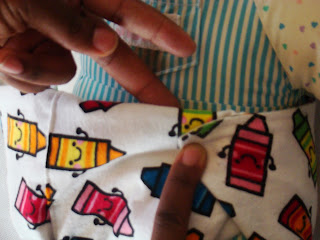A Pre-fold merely suggests absorbency layers pre-folded into a diaper. The following will give you step by step instructions accompanied with pictures to help you successfully pin this style diaper around your baby's bottom.
Your Sadie's Babies flat/pre-fold comes with a tag located at the center back. This tag should face out when folding the diaper around your baby's bottom.
Newborn (NB)/Small Fold:
Flip the flat over so the tag faces down
On the opposite side, fold the fabric down about 3 inches
Along each long edge fold the fabric inward to meet the parallel center stitches
Lay your baby down so the upper edge sits right below the waistline
Bring the corners of the lower edge together...
and pull through the baby's legs opening the corners out. The pre-fold should rest right below the bellybutton. If not, fold the bottom side of the fabric down more.
*You may have to tuck the fabric in at the crotch area so it is not too bulky*
Reach behind and open out the back wings (previously folded corner)
Lay the front tabs down following the contour of the baby's waistline.
Wrap the back wing around and hold in place.
Using your forefinger and middle finger insert them inside the diaper to serve as the barrier between the baby's skin and the safety pin.
Pulling slightly upward, pin the outer and inner layers of the diaper together.
Repeat on the other side to complete.
Don't forget your waterproof cover.
With practice this will be a breeze!






























